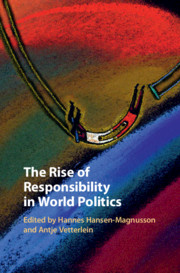Book contents
- The Rise of Responsibility in World Politics
- The Rise of Responsibility in World Politics
- Copyright page
- Contents
- Tables
- Contributors
- Acknowledgements
- Abbreviations
- Part I Introduction
- Part II Security
- Chapter 2 Twisting Sovereignty
- Chapter 3 Negotiating Responsibility in Conventional Weapons Disarmament
- Chapter 4 ‘Coalitions of the Willing’ and the Shared Responsibility to Protect
- Part III Environment
- Part IV Business
- Part V Conclusion
- Bibliography
- Index
Chapter 3 - Negotiating Responsibility in Conventional Weapons Disarmament
from Part II - Security
Published online by Cambridge University Press: 03 December 2020
- The Rise of Responsibility in World Politics
- The Rise of Responsibility in World Politics
- Copyright page
- Contents
- Tables
- Contributors
- Acknowledgements
- Abbreviations
- Part I Introduction
- Part II Security
- Chapter 2 Twisting Sovereignty
- Chapter 3 Negotiating Responsibility in Conventional Weapons Disarmament
- Chapter 4 ‘Coalitions of the Willing’ and the Shared Responsibility to Protect
- Part III Environment
- Part IV Business
- Part V Conclusion
- Bibliography
- Index
Summary
In recent decades, the international community has increasingly sought to regulate and in some cases prohibit weapons systems including anti-personnel mines, cluster munitions, and small arms and light weapons. Yet constraints on the employment of armed violence strike at the very heart of state authority and for this reason, international disarmament efforts have proven controversial and feature enduring debates concerning the content of responsible conduct and the subjects to which such claims can be applied. I contend that there are two fundamentally competing visions of responsible behaviour concerning conventional weapons in contemporary international society, what I term the ‘privilege’ or regulatory approach and the ‘forbearance’ or prohibitionary approach. I employ a case study of the global movement to ban anti-personnel mines to illustrate these dynamics and suggest that, in this case at least, there has been a decisive shift towards a more restrictive conception of responsibility emphasising the elimination of once pervasive weapons.
Keywords
- Type
- Chapter
- Information
- The Rise of Responsibility in World Politics , pp. 55 - 73Publisher: Cambridge University PressPrint publication year: 2020



